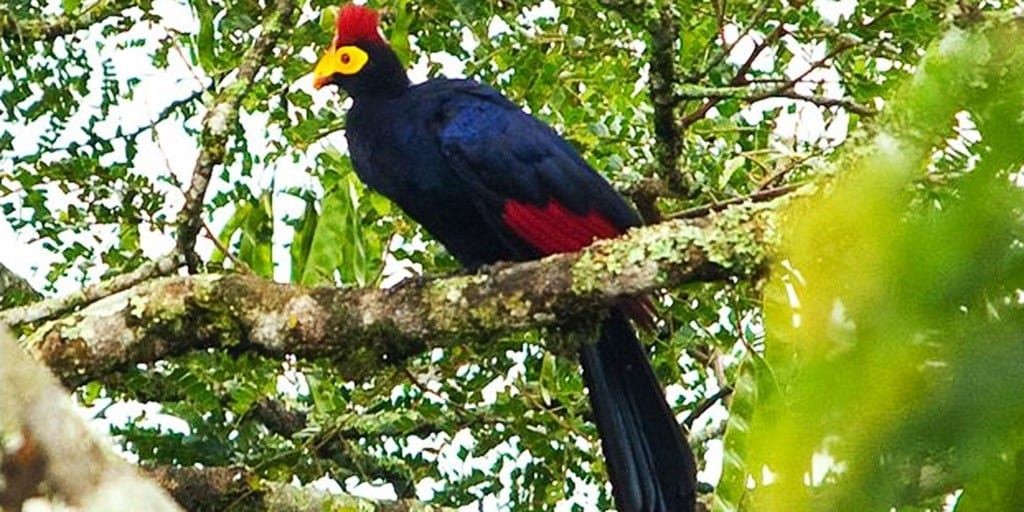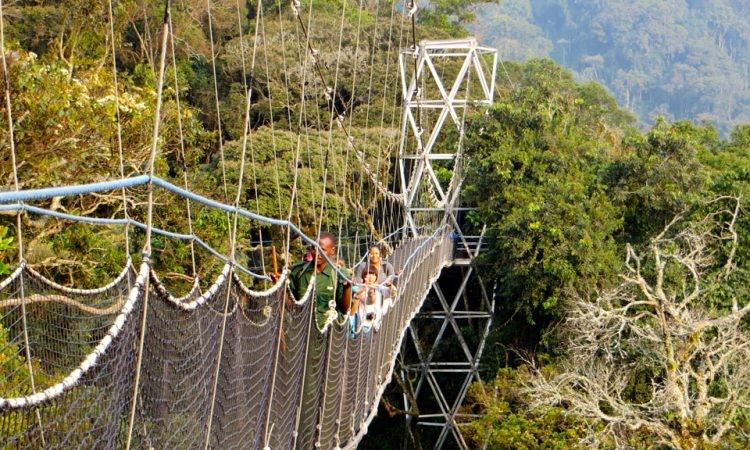- Adventure of a Lifetime
- +256 772 873106
- info@mtrwenzorisafaris.com
Chimpanzee Tracking in Uganda
August 11, 2022
Bigodi Wetland Sanctuary
August 29, 2022Nyungwe Forest National Park | Chimpanzee Tracking in Rwanda
Nyungwe Forest National Park is one of the oldest rainforests in Africa and is located in the South Western part of Rwanda bordering Burundi, Lake Kivu, and the Democratic Republic of Congo (DRC). This park was established in Rwanda in 2004 to help increase the country’s tourism. It sits on an area of 1000 square kilometers with an elevation of 160metres to 2950metres above sea level.
The park is very rich in biodiversity, on a mountainous region teaming with wildlife including a small population of chimpanzees as well as other 12 primate species like the L’hoest monkey which is endemic to the Albertine rift. Nyungwe national park has over 75 known mammals for example mongoose, congo clawless otter, leopard, and serval cat among others.
There are also 1,068 plant species in the park which is also another added advantage to the tourists going to this park for tourism. 332 bird species, 29 Albertine Rift endemic species are also recorded in the park as well as over 120 butterfly species. A trip to Rwanda’s Nyungwe national park is considered incomplete if one does not participate in the photogenic moments along the canopy walk and the Izumo waterfall.
Nyungwe forest has plenty of rainfall and is also known as the major catchment area supplying almost 70% of the country. Nyungwe forest has a variety of attractions which include canopy walks, bird watching, and primate tracking among others.
Bird watching in Nyngwe Forest National Park
Nyungwe forest national park boasts of a variety of bird species and is also known as one of the best birding destinations in Rwanda. This park is a habitat for about 200 bird species of which 120 are forest species and 27 species that are endemic to the Albertine rift and 16 endemics to Nyungwe forest.
Examples of birds in Nyungwe forest national park include the crowned hornbill, African flycatcher, Long crested eagle, Eastern mountain greenbul, purple-breasted sunbird, and Rwenzori batis among others.
Primates in Nyungwe Forest National Park
Nyungwe forest national park is home to 13 primate species and these include the L’hoest monkey, Red colobus, black and white colobus monkeys, grey-cheeked mangabeys and owl-faced monkeys, olive baboons, and bush babies among others. Most visitors to Nyungwe forest national park visit purposely for these primates
Canopy walk in Nyungwe Forest National Park
This comprises 50 and 200metres and is suspended above in the lush montane forest of Nyungwe. This experience provides an exhilarating perspective on the
ancient tree tops as well the forest wildlife. Â After the walk, visitors are also able to see countless butterflies and birds away from the Uwinka Reception center.
Mammals
Because Nyungwe forest has about 75mammal species, this makes it a good idea for most tourists. These include golden cat, serval cat, duiker, bushbuck, hyrax, congo clawless otter, and leopards among others.
Hiking in Nyungwe Forest National Park
Nyungwe has a lot of hiking trails which are of different lengths and at different lengths in the park. Nature lovers, at the end of the day, find this a rewarding experience.
Tracking
Three monkey species in Nyungwe have been habituated for tracking and these are the mangabey, Blue monkeys, and the colobus monkey. Most visitors like tracking the colobus monkey because it is considered to be light and adventurous and is situated in Gisakura at the edge of the park making it very accessible.
Monkey habituation experience
This allows you to spend more time with the monkeys and is also considered one of the most rewarding experiences s you get to take good photographs.
When to go to Nyungwe National Park
Nyungwe forest national park is open to visitors all year round and with a downpour especially in the afternoons.
Accessing Nyungwe forest national park
By road
From Kigali to Nyungwe it is approximately 226kilometres and about 5hours drive. For easy accessibility, you drive through the main route via Muhanga, Nyanza, Huye, Nyamagabe, Nyungwe, and arrive at Gisakura.
By air
The park can be accessed by taking a flight from Kigali airport up to Kamembe airport in Cyangugu about a 30minutes drive to Nyungwe. These flights are organized by Akagera aviation.
Akagera aviation;
This is approved by Rwanda Civil Aviation Authority(RCAA) and offers scheduled flights to Nyungwe national park. Tourists are however encouraged to book in time so that they don’t get inconvenienced the last time.
By water
This is done on Lake Kivu and is also one of the most adventurous ways as you get close to nature.
Related posts
Volcanoes National Park
June 22, 2021Akagera National Park
June 22, 2021Nyungwe Forest National Park | Chimpanzee Tracking in Rwanda
Nyungwe Forest National Park is one of the oldest rainforests in Africa and is located in the South Western part of Rwanda bordering Burundi, Lake Kivu, and the Democratic Republic of Congo (DRC). This park was established in Rwanda in 2004 to help increase the country’s tourism. It sits on an area of 1000 square kilometers with an elevation of 160metres to 2950metres above sea level.
The park is very rich in biodiversity, on a mountainous region teaming with wildlife including a small population of chimpanzees as well as other 12 primate species like the L’hoest monkey which is endemic to the Albertine rift. Nyungwe national park has over 75 known mammals for example mongoose, congo clawless otter, leopard, and serval cat among others.
There are also 1,068 plant species in the park which is also another added advantage to the tourists going to this park for tourism. 332 bird species, 29 Albertine Rift endemic species are also recorded in the park as well as over 120 butterfly species. A trip to Rwanda’s Nyungwe national park is considered incomplete if one does not participate in the photogenic moments along the canopy walk and the Izumo waterfall.
Nyungwe forest has plenty of rainfall and is also known as the major catchment area supplying almost 70% of the country. Nyungwe forest has a variety of attractions which include canopy walks, bird watching, and primate tracking among others.
Bird watching in Nyngwe Forest National Park
Nyungwe forest national park boasts of a variety of bird species and is also known as one of the best birding destinations in Rwanda. This park is a habitat for about 200 bird species of which 120 are forest species and 27 species that are endemic to the Albertine rift and 16 endemics to Nyungwe forest.
Examples of birds in Nyungwe forest national park include the crowned hornbill, African flycatcher, Long crested eagle, Eastern mountain greenbul, purple-breasted sunbird, and Rwenzori batis among others.
Primates in Nyungwe Forest National Park
Nyungwe forest national park is home to 13 primate species and these include the L’hoest monkey, Red colobus, black and white colobus monkeys, grey-cheeked mangabeys and owl-faced monkeys, olive baboons, and bush babies among others. Most visitors to Nyungwe forest national park visit purposely for these primates
Canopy walk in Nyungwe Forest National Park
This comprises 50 and 200metres and is suspended above in the lush montane forest of Nyungwe. This experience provides an exhilarating perspective on the
ancient tree tops as well the forest wildlife. Â After the walk, visitors are also able to see countless butterflies and birds away from the Uwinka Reception center.
Mammals
Because Nyungwe forest has about 75mammal species, this makes it a good idea for most tourists. These include golden cat, serval cat, duiker, bushbuck, hyrax, congo clawless otter, and leopards among others.
Hiking in Nyungwe Forest National Park
Nyungwe has a lot of hiking trails which are of different lengths and at different lengths in the park. Nature lovers, at the end of the day, find this a rewarding experience.
Tracking
Three monkey species in Nyungwe have been habituated for tracking and these are the mangabey, Blue monkeys, and the colobus monkey. Most visitors like tracking the colobus monkey because it is considered to be light and adventurous and is situated in Gisakura at the edge of the park making it very accessible.
Monkey habituation experience
This allows you to spend more time with the monkeys and is also considered one of the most rewarding experiences s you get to take good photographs.
When to go to Nyungwe National Park
Nyungwe forest national park is open to visitors all year round and with a downpour especially in the afternoons.
Accessing Nyungwe forest national park
By road
From Kigali to Nyungwe it is approximately 226kilometres and about 5hours drive. For easy accessibility, you drive through the main route via Muhanga, Nyanza, Huye, Nyamagabe, Nyungwe, and arrive at Gisakura.
By air
The park can be accessed by taking a flight from Kigali airport up to Kamembe airport in Cyangugu about a 30minutes drive to Nyungwe. These flights are organized by Akagera aviation.
Akagera aviation;
This is approved by Rwanda Civil Aviation Authority(RCAA) and offers scheduled flights to Nyungwe national park. Tourists are however encouraged to book in time so that they don’t get inconvenienced the last time.
By water
This is done on Lake Kivu and is also one of the most adventurous ways as you get close to nature.
Comments are closed.







